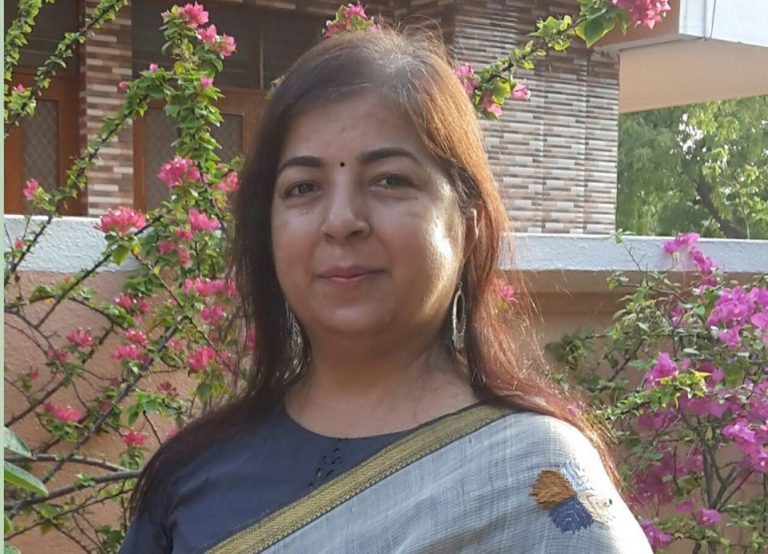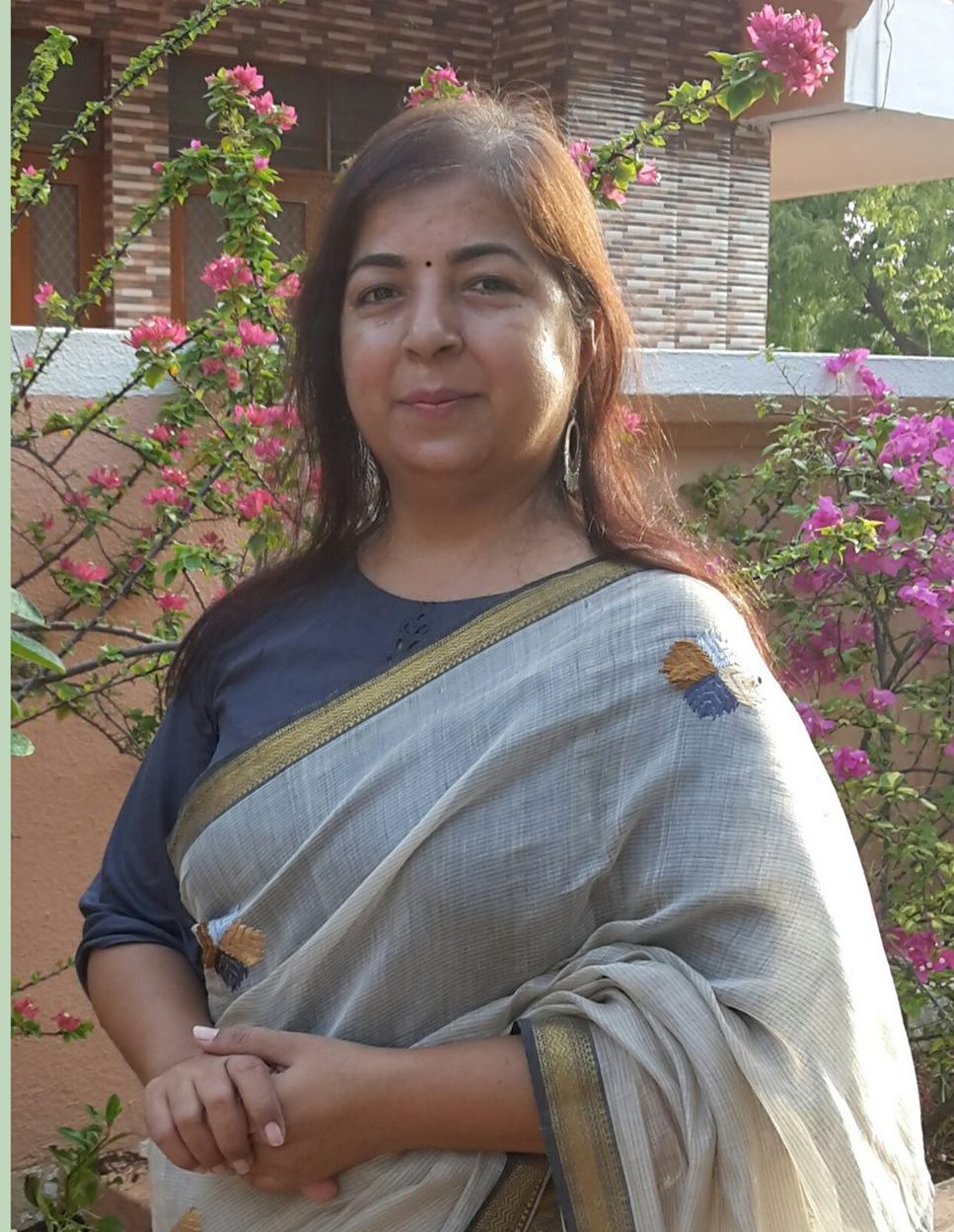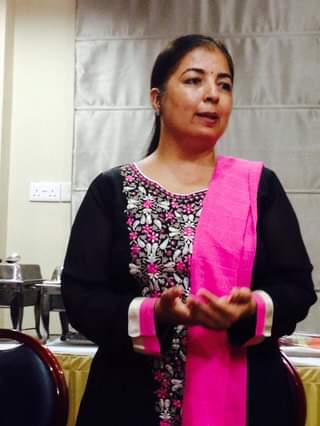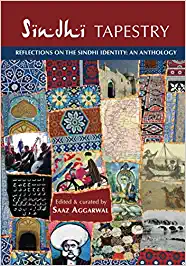
I am so fortunate that, though I was born in Bharat, my family environment and the books I read introduced me to Sindh and gave me a strong emotional bond to it. Even my poems somehow embody expressions of Sindh!
Vimmi Sadarangani
René Descartes famously said, “Cogito ergo sum – I think, therefore I am,” a premise that underlines the most basic of all aspects of human nature, self-consciousness. ‘I’ is, in all probability, the most important word a human has ever spoken.
I grew up in Adipur-Gandhidham, a township developed by Bhai Prata Dialdas, to resettle the Hindus of Sindh displaced by the Partition of India. My journey of exploring my Sindhi identity began in primary school, when children would tease Sindhi speaking-children, calling out, “Sindhi saeen, papad khaaeen, papad kacho, pet mein bacho!”
Sindhi saeen … papad … a child in the belly – why were these words used as taunts? I had no idea. What I did know was that I was being taunted. And I could never think of a suitable response. So, to stop them, I would say, “But I’m not a Sindhi! And I don’t even eat papad.” And, slowly, these word became a reality in my life. In my family, everyone loved papad, but I firmly refrained from eating it.

At school, my teachers admired my beautiful Hindi lettering and sensitive responses, and praised me. I remember one of them who would say, “It is rare for a Sindhi to speak such good Hindi! You sound like a native speaker of Hindi.” It only occurred to me later, that the one who was responsible for improving my Hindi conversation was my mother. And it was my father who had worked with me on my Hindi handwriting.
We had a Gujarati aunty living next door, and she would affectionately comb my long, thick hair, coiling it into a large bun. And she would say to my mother with amusement, “Your daughter does not look like a Sindhi! She has such a lovely round face. And her hair is as beautiful as our Gujarati hair.” I would smile, feeling happy and proud to hear this.
At school and in the neighborhood, my Sindhi identity was increasingly suppressed, but it remained alive within. When I refused papad while visiting relatives, turned away from the beeh they had prepared, I would hear the elders say, “This girl is a half-Sindhan!” I would do the Maths, and feel unhappy. If I don’t eat papad, I’m a half-Sindhan. If I don’t eat beeh – I’m a half-Sindhan. So that means I’m not Sindhi at all! And then I would quarrel with my phuppi, with my mami. Where is it written that to be a Sindhi it’s compulsory to eat papad and beeh? I don’t eat papad, I don’t eat beeh, but I AM a Sindhi.
At school and in the neighborhood, my Sindhi identity was increasingly suppressed, but it remained alive within.
In our home, we celebrated Cheti Chand, Mahalakshmi Sagdo, Thadri, Holi, Diwali and other festivals. We played Garba with our neighbours on Navratri, and enjoyed Ramleela too. On birthdays and every auspicious occasion, Ma would make kanaah prasad and we would go to the Gurmandar. In our little temple at home, Jhulelal Saeen, Guru Nanakji, and other gods and goddesses were worshipped with equal devotion. Neighbours who visited us would ask in surprise, “Which of these is your god? If your god is Jhulelal, why have you kept the other gods and goddesses along with him? Which one do you actually believe in?” And Ma would reply, very simply, “We believe in all of them.”
Along with our schoolwork, I had also started reading other books, and this was a habit I had inherited from my father. These were Hindi books. I did see Sindhi books being read by my nanaji and elder masi in Jaipur, but was never interested in finding out more about them.
When I was in class seven, our teacher gave us a form that was to be filled at home and returned to her. One of the things we had to write was our ‘native place’. Ma said, “Our native place is Hyderabad. But just write Ajmer. That’s where you were born.” I was surprised to hear that our native place was Hyderabad! That meant that we were from South India! Why had we never visited? On our holidays we only ever went to Ajmer and Jaipur. Why?
That was the day I learnt that there was another Hyderabad, and that it was in Sindh. But now we could never go there. My mother had been born in that Hyderabad. And so had my father. Before India became independent.
I had so many questions about this Hyderabad, Sindh! Ma and Papa did try to answer my questions, but their answers confused me even more. And my confusion and search for answers began to percolate among the other adults of my family too. I began to hear the names of cities, of villages, what life had been like in Sindh. All that I learnt seemed to get absorbed inside me, and I had more and more questions. Why did we have no photos of Sindh? Why wasn’t there a photo of our home there? These questions slowly created an awareness about identity and a realization of what it meant to be Sindhi.
The hidden treasure
When I was in class eight, a writer from Kolkata, Lakhmi Khilani, came to speak at a function in my school. I listened attentively to him explaining that it was essential for us to study Sindhi at school. If not – how could we consider ourselves Sindhi? He told us about Sindh, about Sindhi Literature, about Partition, and the complex struggles of Sindhi society. I clearly remember the moment, at the end of his talk, when I spontaneously raised my right hand to answer his question, “Now tell me, children, which of you is going to take Sindhi as a subject in school from tomorrow onwards?”
 When I came home and told my mother, she was thrilled. Next day onwards, I sat in the Sindhi language class. The Sindhi books looked just like the Hindi ones I was used to, because they were written in Devanagari. With the help of my Sindhi teacher, Rajni didi, I was soon able to write good-quality Devanagari Sindhi. At home, Ma helped me with my studies. I had studied Kabir, Meera, Premchand, Subhadrakumari, Mahadevi Varma in Hindi class; I now began to read the great Sindhi poets Shah Latif, Sachal Sarmast, Sami, as well as the writings of Gobind Malhi, Narayan Shyam, Popati Hiranandani, Krishn Khatwani and other contemporary Sindhi writers.
When I came home and told my mother, she was thrilled. Next day onwards, I sat in the Sindhi language class. The Sindhi books looked just like the Hindi ones I was used to, because they were written in Devanagari. With the help of my Sindhi teacher, Rajni didi, I was soon able to write good-quality Devanagari Sindhi. At home, Ma helped me with my studies. I had studied Kabir, Meera, Premchand, Subhadrakumari, Mahadevi Varma in Hindi class; I now began to read the great Sindhi poets Shah Latif, Sachal Sarmast, Sami, as well as the writings of Gobind Malhi, Narayan Shyam, Popati Hiranandani, Krishn Khatwani and other contemporary Sindhi writers.
I learnt that there was a profusion of Sindhi writers – excellent Sindhi writers. At school, along with Hindi functions, I began to take part in Sindhi functions too.
Ma was happy – but still not satisfied. Every week, we would receive at least two letters from nanaji and Meera masi in Jaipur, and once or twice a month a letter from Gul mama and Maina masi too. Seeing the postman entering our lane, I would run and bring the letters to her, impatient for her to open and read them out to me. Each of these letters were of two or three pages, but they were all in Sindhi – what my mother called ‘Arbi Sindhi’. But one or two paragraphs would be written to me, in Hindi. Such long letters, and just one paragraph for me? Ma would look at my sulky face and say, “If you learn Arbi Sindhi, the whole letter will be for you!” But I did not feel attracted to the strange circular alphabets with crooked lines and so many dots! One paragraph was enough for me. And Ma would laugh.
When I completed my schooling, I would have liked to study Language and Literature, but these options were not available to me then so I took admission in the BA course at Tolani Arts and Science College, with Economics, History and Political Science as my subjects and continued with Economics for MA. I started writing Hindi poems in my notebook. I completed my first year MA and we had holidays while awaiting the results. One day, Ma told me that an excellent teacher of her schooldays was visiting Adipur. We went to see him in a building that looked like a residence but had a board outside, ‘Indian Institute of Sindhology’. I heard my mother telling him, “Dada, please teach my daughter Sindhi! I want her to learn our script.”
He was her schoolteacher, Dr. Satish Rohra, and he had retired to Adipur, from Agra Kendriya Hindi Sansthan. Along with Pritam Varyani, who had retired from Pune’s Western Regional Languages Centre, and Lakhmi Khilani, who left his engineering and construction work, to create awareness about Sindhi culture, to preserve and propagate it, and to build a foundation for pride in our language, literature, history and philosophy. They established Indian Institute of Sindhology. Over time, they were supported in their mission by Harish Vaswani, Sugnaram Ladkani, Nirmal Vaswani, Parasram Varandani, Hari Meraney, Sahib Bijani and many others.
I had an MA in Economics, and now I did MA in Sindhi and Hindi Literature, and PhD in Hindi with a topic related to the problems of translation between Sindhi and Hindi.
I attended the introductory Sindhi Perso-Arabic script class organized by Sindhology and then practiced for three months. I also became associated with the Institute, first volunteering in the office and then in the research department.
Learning the Perso-Arabic script of Sindhi was, for me, the opening of a hidden treasure.
With Ma’s love and the nurturing environment of Sindhology, the poet waiting inside me began to express itself in Sindhi. There was a time when I had seen the Sindhi alphabets only as strange circular letters with crooked lines and many dots. But now, as I began to recognize each one, and they came together with beautiful words and sentences, I was finally able to claim my language, my mother tongue.
I had an MA in Economics, and now I did MA in Sindhi and Hindi Literature, and PhD in Hindi with a topic related to the problems of translation between Sindhi and Hindi.
Since 1995, I have worked as an Associate Professor of Sindhi at Tolani College of Arts and Science. The college is managed by the Gandhidham Collegiate Board, established by Sindhi leader, Kaka Pribhdas Tolani, a zamindar with a huge holding in Sindh who had lost everything at Partition. He slowly rebuilt his family’s fortunes, and then came to Gandhidham to set up institutes of higher education for the children of our displaced community. Today, the Tolani Vidya Mandar has eight colleges, which offer a wide spectrum of academic choices and more than nine thousand students from all over Gujarat.
Very few Sindhi students take admission in Arts – just about one percent, so Sindhi classes have just a handful of students. We work hard to create an awareness among parents and school children that there is a facility to study Sindhi and to make it interesting to them.
Kunne ja beeh
Who can blame our young people who are not interested in learning their mother tongue? Who can blame their parents and grandparents for not teaching it to them? No matter which way we look at it, if blame can be assigned in any quarter, it can only be on that political event that changed everything for Sindhis, removed them from their homeland and scattered them around India and many other countries: the Partition of India.
For us Sindhis, Independence Day is also the day of Partition. The separation of India on the basis of religion separated Sindhi society too, into Sindhi Hindus and Sindhi Muslims. Our separation, and subsequent displacement, was not a simple matter of roti-kapda-makaan – it was not just sustenance, because the resettlement also involved complex issues of society, religion and mental health. But with courage, hard work and patience, they rebuilt their lives. The Sindhis who were born in Sindh have continued to pine for the land of their birth. Some continue to weep with the longing to feel again the smear of earth from their ancestral village on their foreheads. But the political relationship between the two countries makes things difficult.
I never imagined that the Sindh I had never seen, the Sindh that unexpectedly found its way into my poems, the Sindh which I envisioned as one might envision a pen friend while writing, would one day become a reality to me, that I would miraculously get a chance to visit the land and meet the Sindhis of Sindh.
I am so fortunate that, though I was born in Bharat, my family environment and the books I read introduced me to Sindh and gave me a strong emotional bond to it. Even my poems somehow embody expressions of Sindh!
I never imagined that the Sindh I had never seen, the Sindh that unexpectedly found its way into my poems, the Sindh which I envisioned as one might envision a pen friend while writing, would one day become a reality to me, that I would miraculously get a chance to visit the land and meet the Sindhis of Sindh.
It was in 2004 that the Sindh Graduate Association and the Sindhi Akademi, Delhi, were the first delegation that participated in an international conference in Karachi, and I was fortunate to be one of them. I went again in 2012, to participate in the international conference held on the Urs of the great Sindhi Sufi poet, Shah Abdul Latif.
On the journey from Karachi to Keenjhar Lake in Sindh, we got glimpses of Sindhi history, visited cities and villages, wandered in their lanes, enjoyed the music of Sindh; the beauty of Sindhi handicrafts. We met Sindhi writers and artists, we ate Sindhi food – it was like a waking dream, an incomparable experience. In the birthplace of my parents, my Sindhi pride could at last be connected with the land.
And yes – in Sindh I also ate kunne ja beeh (lotus stem cooked in an earthen pot)! That beeh gave me a satisfaction that I simply cannot describe. When I was little and refused to eat beeh, I was called ‘half- Sindhan’. In Sindh, eating its delicious beeh, redolent with the water and earth of our Sindh, finally gave me the opportunity to feel like a real, complete, Sindhi.
Even if one is ignorant of the Sindhi language and heritage, a person born into a Sindhi family will always have a Sindhi identity. The feeling of completeness when I found my identity when I connected with my cultural and social heritage was something special and makes me feel very privileged. For me, it was the process of studying Sindhi language and literature, and the process of feeling them deeply as a part of my own identity, which formed the crux of the story of how I discovered and began to experience my Sindhiness.
(TRANSLATED FROM HINDI INTO ENGLISH BY SAAZ AGGARWAL)
_______________
A NOTED SINDHI POET, VIMMI SADARANGANI IS AN ASSOCIATE PROFESSOR OF SINDHI AT TOLANI COLLEGE OF ARTS AND SCIENCE, ADIPUR, SINCE 1995. VIMMI HAS ALSO TAUGHT A SINDHI LANGUAGE COURSE AT SINGAPORE SINDHI ASSOCIATION (1995) AND UNIVERSITY OF ILLINOIS, US (2000). HER PHD FROM GUJARAT UNIVERSITY IN 2010 WAS ON THE PROBLEMS OF TRANSLATION BETWEEN HINDI AND SINDHI. SHE HAS WRITTEN FIFTEEN BOOKS OF POEMS, CHILDREN’S LITERATURE AND SINDHI LANGUAGE LEARNING. VIMMI HAS RECEIVED SEVERAL AWARDS FOR HER CONTRIBUTION TO LITERATURE AND EDUCATION FROM GUJARAT SINDHI ACADEMY, NCERT, SINDHI ACADEMY (DELHI), AKHIL BHARAT SINDHI BOLI AI SAHIT SABHA, SINDHU WELFARE TRUST (JAIPUR), SPARROW (MUMBAI) AND OTHER ORGANIZATIONS. SHE IS THE LOCAL ORGANIZER OF 100 THOUSAND POETS FOR CHANGE, AN INTERNATIONAL ANNUAL POETRY EVENT OF BIGBRIDGE, US SINCE 2011.
 Excerpted with permission from Sindhi Tapestry: an anthology of reflections on the Sindhi identity.
Excerpted with permission from Sindhi Tapestry: an anthology of reflections on the Sindhi identity.
Courtesy: Sindhi Samaachar (Received through email)